 |
A part of the IAGenWeb and USGenWeb Projects Daniel Stephenson, Weaver of Coverlets & Carpets |
 |
 |
A part of the IAGenWeb and USGenWeb Projects Daniel Stephenson, Weaver of Coverlets & Carpets |
 |
In 1840 there came to America a 17-year-old lad, Daniel Stephenson, and his father from England. The lad's uncle, father and a brother were weavers, and Daniel worked with them winding bobbins. In 1848 he decided to learn coverlet weaving, and apprenticed for two years in Ohio to learn the trade. For another two years he worked in Canada, chopping wood in the winter and returning to New York in the summer to weave in the mills at Geneva. Beginning in 1852, with the first piece of machinery in the city of Fairfield, Daniel Stephenson began weaving coverlets. This he continued until about 1877, when the demand for coverlets died out, and he thereafter turned to carpet weaving.
Below are several articles about Daniel Stephenson and his weaving. Occasionally we hear of someone with one of the Stephenson coverlets, usually handed down through their family or found at a garage sale. An inquiry in November, 2011, from Randy Schultz in Colorado, who has owned an 1858 coverlet since the mid-1980s, prompted the creation of this webpage. Near the end of the page are four photos of his prized possession. We thank you, Randy, for sharing this lovely antique with us.
In April, 2015, I received a couple photos of another Stephenson coverlet which was made in 1868, and was owned by Phyllis Skocypiec in Arizona. Phyllis kindly sent this coverlet to the Carnegie Museum at the Fairfield Public Library for display, to join five other coverlets there. Photos of Phyllis' coverlet are below Randy's. Thank you for sharing!
In February, 2020, another coverlet owner, Billie Lynn McDavitt, shared photos of her prized possession, which was made in 1855. This one was purchased in 1856 by her great-great-great grandparents, Adam and Sarah Gift, as a wedding present to their son William. In 1878, when William and Catherine's daughter Sarah Jane married, the coverlet was given to Sarah Jane and her husband James Albert Neil. Years later, in 1922, when James and Sarah's son Walter was married to MaeBelle Gallop, Walter and his bride were given the coverlet. About 1982, MaeBelle handed down the coverlet to her granddaughter, Billie. As with the other coverlets, Billie's is in wonderful shape. The four photos of her treasure appear at the bottom of this page. Thank you for sharing!
"The Fairfield Ledger"
Tuesday, November 17, 1987
DANIEL STEPHENSON - COVERLET MAKER AND WEAVER
by Lillian Thada
The information for today's column comes to us through the courtesy of Everett McAllister of Mt. Pleasant and concerns Daniel Stephenson who made coverlets and also became a carpet weaver after the demand for coverlets ended. There are about twelve Stephenson coverlets owned by Fairfield people at the present time. One of them was on display by Ben and Lucille Taylor at the recent Historical Society Open House. Since Mr. McAllister has collected a lot of information about the Stephenson family, let's enjoy reminiscing about them and especially Daniel whose name still endures today.
Some of this information is direct quotes while other bits are summarizations. From an obituary in the Fairfield Ledger of August 24, 1892 we learn that Daniel was born in Yorkshire, England, 1823, the son of a family of weavers and he worked with them as a bobbin winder. At the age of seventeen, he and his father came to America. For five years they worked in New York, Massachusetts and Ohio to get enough money to bring the rest of the family to the United States.
About that time an uncle, Abel Stephenson, had landed in Lockridge Township. He sent word to Daniel's father that if he would come to Iowa, he could have the property. Daniel asked his father if he would let him go to Iowa to find that land. Agreed. Daniel came to Chicago by the way of the lakes and then found it would take all of his money to pay the stage fare to Iowa, leaving nothing to live on. So he decided to walk the whole distance, arriving in June, 1845.
Now follows a direct quote from the Fairfield Ledger, May 25, 1928, written by a daughter, Lovinia Stephenson Snyder, called "How Daniel Stephenson, Weaver, came to Fairfield." She gives such interesting details and a fine picture of what it took to come to this land.
"My grandfather and father first sailed from England and came to America in 1840 when father was 17 years old. It took them 25 days to cross the briny deep and that was considered a quick voyage at the time. Grandfather came west and secured a fairly good job in Springfield, Ohio, and left father (Daniel) at Geneva, a town on Seneca Lake, N.Y. He was to stay there so as to be handy to meet grandmother and the other five children. They were given orders to come up the Hudson River to Poughkeepsie. Father, when he thought it was about the right time, went to the Hudson. Just as he was walking across the bridge, he saw grandmother starting out across at the end of the dock below him, with a little bucket to get some milk for their breakfast. Father called to her, and she looked and exclaimed, Oh, there is our Daniel.'
"Grandfather had a brother who had come to America three years earlier, had come to Iowa, and had entered 160 acres of land in 1838. As he was an old bachelor and weaver, he wanted to go back East where he could work at his trade. He told grandfather if he would come to Iowa and live on the land and improve it, he would not charge any rent. They thought that was a wonderful offer. So they decided that my father was to come first and locate the land. When he arrived in Fairfield, he went to the land office and soon found the land. It was twelve miles east. (Lockridge)
"The next thing was to build a log house and prepare all he could for the rest of the family. They started to come in the fall, down the Ohio River, and up the Mississippi. They got as far as Keokuk and the river froze up, so they had to stay there until spring. Then as soon as they could, they resumed their journey and landed here in April, 1846.
"The country was new with lots of swamps and decayed vegetation and lots of fever and ague. Grandmother walked about two miles to minister to a very sick neighbor lady. She had to go through tall grass and weeds. It was early in the morning and she got very wet with the dew. In a day or two, she took down very sick with a hard chill, and that night grandfather called to the children who were sleeping in the loft, that he believed grandmother was dying. Before they had time to summon medical aid, she passed away. Father said it seemed to him that she just got a glimpse of the promised land.
"In 1848 my father told grandfather he'd like to learn coverlet weaving. Grandfather advised him to go to Springfield, Ohio. So he wrote to a man, Robert Crosley. He wrote back that he would take him on as an apprentice for two years if he would agree to not start up in a business closer than 200 miles. Father told him it was his intention to come to Iowa and start up."
The Iowan, Aug.-Sept. 1961 carries an article named "Antiques" by Pauline Milien. She gives credit to Mr. and Mrs. Ben Taylor for much help in researching. Following is the quote from The Iowan.
"He began weaving in Fairfield in 1852. The wool for one coverlet now belonging to Mrs. Elmer Larson came from Grandfather Dallner's sheep, was spun in Bonaparte, Iowa woolen mills. Mr. Stephenson dyed all of the yarn himself and furnished the cotton warp." [Full text of the article.]
In the "Homes of Fairfield" from the Daily Ledger, Nov. 30, 1932, is a paragraph about a home at 304 East Burlington. "In olden times, prior to 1870, Daniel Stephenson lived here, carrying on a weaver's shop and making fine coverlets and fine weavings. His reputation was far and wide and inquiries still come here for his goods." The present house was built in 1895 by Dr. T.L. James.
Apparently he lived at the East Burlington residence for about twenty years. Children of the neighborhood used to gather at the windows and watch that little man work away. His foot provided the motor power. At that time his loom was the only one in the county and probably one of the first west of the Mississippi. He would work all kinds of designs of wonderful birds and flowers into his coverlets. Evidently he was very particular and thorough in his work.
In the fall of 1877, the demand for coverlets was over, so he and his family moved to a farm three miles north of Fairfield where he died July 19, 1892.
According to tombstones in the Old Fairfield Cemetery, Lot #130, Daniel and Jane, his wife, both died in 1892. Children Ida and Ann, died in 1870 and Richard in 1857 (age one month). Daughter Lovinia Snyder died in 1943.

"The Fairfield Ledger"
Saturday, November 11, 1967
At Public Library--
Stephenson Coverlet Is Hamilton Memorial
The Fairfield Public Library is the repository for another priceless bit of Fairfield memorabilia -- a Stephenson handmade coverlet.
The permanent gift to the library had been the property of Mrs. Milo Hamilton, and upon her death it went to her sister, Mrs. Alice Donald Noble of Des Moines. This fall Mrs. Noble sent the coverlet to the library as a memorial to her sister and brother-in-law, Mr. and Mrs. Hamilton, well-known Fairfielders.
Presently the coverlet is on display in a glass case in the children's room at the library building. Later it will be given a permanent home in the museum.
Famed Weaver
The coverlet was woven by Daniel Stephenson whose loom products have been gaining tremendously in value. They are highly prized for their historical value, and as being typical of an art that has passed, and of a quality of workmanship as true and as steady as the characters of the people of the era.
Daniel Stephenson was born July 12, 1823 in England and with his father, came to America in 1840. His father and brothers were weavers, and he walked from Chicago to Iowa in June 1845. After more than one trip to Iowa he married Mary Ellen Dodson in Van Buren County in 1852 and became the father of seven children. One grandson, Robert Snyder lives in Birmingham, and the other, Simon Snyder lives at 304 S. Fourth. He died in 1892 and is buried in Evergreen Cemetery (sic - Old Fairfield Cemetery).
For many years the weaver's loom was the only piece of machinery in Fairfield, and the children of the town gathered at windows of the little frame building on east Burlington to watch the shuttle fly back and forth, and see the design take shape.
Draft Book
Stephenson's draft book shows that he made many of his own designs for his artistic coverlets. The book, with its drafts, or patterns, is now in the Art Institute in Chicago and has special interest locally because of the entries of accounts against some of the pioneers of this country.
Other entries show the prices he charged for his work (around $3.50 to $5), recipes for making soap and dyes, and clever weaving hints. All of the master weaver's coverlets bore the legend: "Made by D. Stephenson, Fairfield, Jefferson County, Iowa," and the date, woven into the fabric in well formed and conspicuous letters. Though the legend was usually in a corner, there are examples of its having been woven into borders.
The coverlets date from 1854 through 1876. Stephenson was evidently fond of curved lines, for in all his work he has used few straight lines. Flowers and birds are frequently incorporated into the design. He often entered his weavings at the county fairs and lists of his prizes were carried in the Daily Ledger from 1855 through 1860. [1855, 1856, 1858.]
History Of Gift
The coverlet at the library was made for Eliner Langner in 1868. The wool was taken from the sheep that were raised on the Langner farm at Four Corners then taken to the carding mill of George Hanson at Lockridge.
After the carding, Mrs. Langner made the coloring dyes from peach seeds for green; indigo for blue, and powdered madder for red.
As soon as the colors were set, the reel was used to make the yarn into skeins for the weaver. The weaver furnished the double and twisted chain and with the yarn in three colors produced the beautiful coverlet. It was woven in Stephenson's shop at 304 E. Burlington.
The following account is contributed by James Nelson, Fairfield, Iowa
TRANSCRIPT OF PEN-WRITTEN NOTES MADE BY LAVINA MAE STEPHENSON SNYDER
DAUGHTER OF DANIEL STEPHENSON, NATIVE OF ENGLAND, LATER CITIZEN OF U.S.A.
Fairfield, Iowa, June 27, 1938.
My father, Daniel Stephenson, was born July 12, 1823 near Huddersfield, Yorkshire County, England, and with grandfather came to America in 1840. It took them three years to earn enough to send back for grandmother and the other five children. Their principal occupation was weaving in factories, one at Geneva on Seneca Lake, N.Y. and one in Springfield, Ohio. They had to take pay for their work in goods, then in order to turn it into cash, take a big discount. They thought they were doing extra well if they could make 25 cents a day.
The winter of 1843-4 the work at the factory at Geneva stopped. Grandfather came on west to Springfield, Ohio and secured work, and father and a fellow by the name of Jack Lenard (perhaps Leonard) went over into Canada and secured a job chopping wood. They put up a little log shanty in the woods and batched. Father cut a hundred cords of wood that winter, at 25 cents a cord, then in the spring of 1844, when the work opened up at the factory at Geneva he went there so as to be handy when grandmother came. They gave her orders to come up the Hudson River to Poughkeepsie. When father thought it about time for her to land, he went to meet her, and as he was walking across the bridge he looked down and saw grandmother starting out across the dock at the end of the bridge with a little tim (sic) pail in her hand to get some milk for their breakfast. He called to her and she looked up and exclaimed: "Ah, there is our Daniel!"
Grandfather had a batchelor (sic) brother who had come to Iowa in 1838 and "entered" a hundred and sixty acres of land. He told grandfather that if he would come to Iowa and live on the land and improve it he would not charge him any rent, so they thought that was a very good offer. So father being the oldest boy here, it was decided he must come first and find the land. They raked up all the money they could for him which was about $12. He came by way of the Great Lakes to Chicago and went to the stage office and asked what they would bring him to Burlington, Iowa for. They told him Six Dollars. That was all he had left (by that time) except 25 cents. He thought he could not live on that, so decided to walk it. He got to ride the first day about four miles out with a country farmer. With the exception of that, he walked every step of the way to Fairfield. One late afternoon as he was coming across Illinois he came to the edge of a big prairie. They told him it was 8 miles without any house and that he had better not start across as it was then three oclock. But he was anxious to get here. He started and walked as hard as he could. Night came and still no house in sight, and not much of a road, about like a sheeps path through the tall prairie grass, higher than his head. Finally about nine o'clock he saw a light. He made for that and rapped at the door and asked to stay all night. They hesitated a little -- said they were new-comers themselves, and not fixed for keeping travelors (sic). He told them he was on his way to Iowa and if they would let him stay he would be glad to sleep on the floor.
He said he had never had a better nights sleep in his life as he was so tired. Got up in the morning very much refreshed and feeling good. As he was coming along through the tall grass especially when dark came on he could hear night prowling animals of different kinds. Something would - - - - - (thus ends the memo found by Simon Snyder)
"The Fairfield Daily Ledger-Journal"
Wednesday, January 4, 1922
Page 1, Column 6
ECHO OF WHIRR OF AN OLD LOOM.
The Collection of Stephenson Coverlids (sic) at Historical Exhibit.
Seventy years ago the only whirr and clang of machinery heard in Fairfield was in a little frame building at what later became the Dr. James property on East Burlington Street, where Daniel Stephenson plied his trade as weaver, his foot furnishing the motive power, and produced those wonderful coverlets of which another generation knows nothing of making.
In this little home Stephenson's shuttle flew back and forth for twenty years or more, and the children of the neighborhood used to gather at the windows and watch with awe this spare little man work imperishable designs of wonderful birds and flowers into his warp and woof (sic - warp and weft). Not only the children of the neighborhood but also the children of all the town used to come and watch, for Stephenson's loom was the only piece of machinery in the town in that day, the only loom in the county and probably one of the first west of the Mississippi River.
Typical of Art.
Today Stephenson's loom products have a new value. It is not alone the historical value, although they should be highly prized as such; they have a value as being typical of an art that has passed and of a quality of workmanship as true and as steady as the characters of the men and women of that age.
So it is that special interest attaches just now to the announcement that these rare old weaves will be displayed at the historical loan exhibit at the library January 10-16....
To America In 1827 (sic - 1840).
Daniel Stephenson knew his trade as the weavers of that day learned it and all of his work that has been seen betrays his thoroughness. As a small English boy he came to America in 1827 (sic - 1840) and was apprenticed to a weaver in the east when he had reached a proper age. After working at his trade in various places he came to Springfield, Ohio. But the unknown west held an urge for him and he started out on foot for Iowa. He came to Chicago but thought the place had no future, so hurried on his way, reaching Jefferson County in 1845.
At Fairfield he found the population too small, (and probably too poor, although history does not record it) to justify setting up a loom. So he returned to Ohio. But he still felt the lure of the west, so again came to Fairfield in 1850, and set up his loom. How long he remained in the city, plying his trade, does not appear quite clearly but it must have been as late as 1876, as one of his coverlets bears that date.
Entries In Draft Book.
Daniel Stephenson's old draft book shows that he made many of his own designs for his artistic coverlets. This old book, entries in which were begun in the thirties, is faded and worn, but its records of the drafts or patterns for his wonderful coverlets are clear. The book, which is now in the Art Institute in Chicago, has peculiar interest locally because of some of the entries showing his accounts against some of the pioneers of this country. Other entries showed the prices he charged for his work, recipes for making soap and dyes, cunnings hints as to weaving for his reference; now and then words of an old song were written in the book. One memoranda gives an idea of the pay received for expert labor in those days, and reads: "Port Huron, Canada, August, 1850: Commenced work for Messrs. Clark & Hoblett at $14.00 per month and found as head weaver."
All of these entries were written in old copperplate hand of surpassing beauty. All of Stephenson's coverlets bore the legend: "Made by D. Stephenson, Fairfield, Jefferson County, Iowa," and the date, woven into the fabric in well formed and conspicuous letters. This was usually placed in the corner, but V. A. Lamson has one specimen which bears the legend woven into the border at each end of the coverlet and extending its full width. The name and address appears four times at each end and is woven in reverse alternately so that it may be read in its proper form on the reverse side of the coverlet. These indelible imprints of the maker authenticate their manufacture and their age and are of special value to collectors.
Old Settlers Overlook Prize.
"I am surprised that the Old Settlers Association has overlooked such historical relics as the loom, shuttles and other equipment of the first weaver of Jefferson County," Mr. Lamson states. "These valuable relics are now in the possession of a daughter of Stephenson's, who lives just northwest of the city and preserves and treasures them with loving care."
The oldest coverlet made by Stephenson, owned by Mr. Lamson, bears the date of 1854. In the borders of this the maker's name and address are cleverly woven. The design, much like all of his work in general character, is a blue and white floral, conventional.
Another, made in 1855, is much the same in general characteristics of design and gives rise to the belief that it is the weaver's own design. Three others, dated 1868, 1869, and 1876, betray the weaver's fondness for curved lines. In all of his work he has used few straight lines, flowers and birds seeming to have held the greatest decorative charm for him.
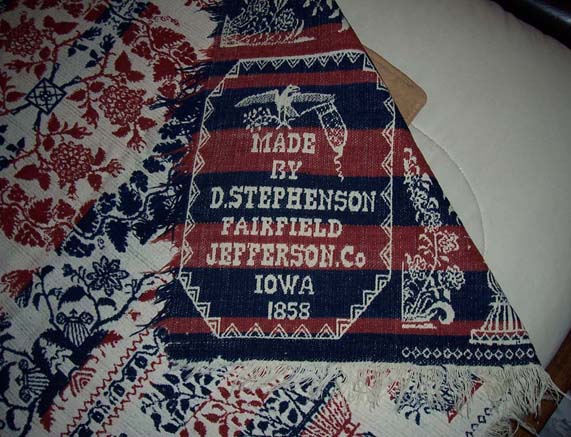 |
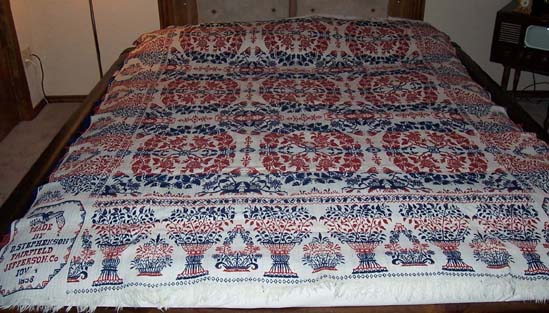 |
 |
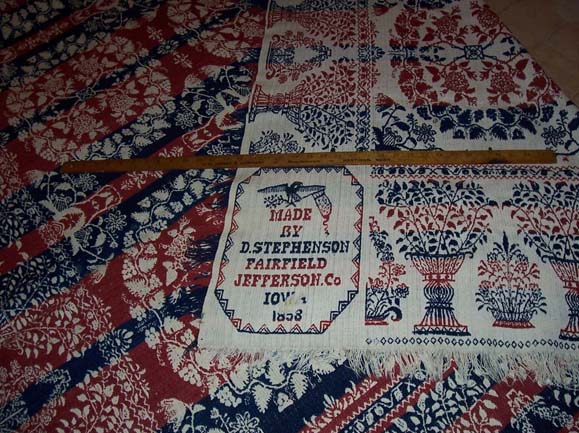 |
Despite its age, Randy's coverlet is in wonderful shape. Without the fringe it measures 70" wide and 82" long. Randy relates there is some minor fringe loss at the top and minimal fraying but the colors are still very vibrant. There is one flaw which can be seen in the logo on the lighter side in the last photo.
The photos below are those of Phyllis Skocypiec's coverlet... in excellent shape for being more than 150 years old!
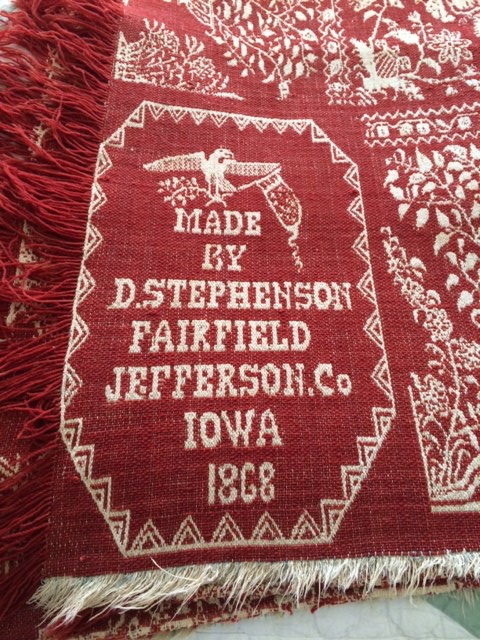 |
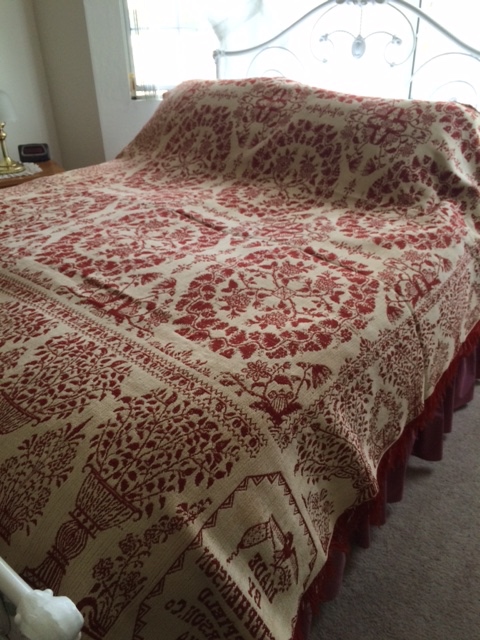 |
These photos are of Billie McDavitt's coverlet, originally purchased in 1856 by her great-great-great grandparents, Adam and Sarah Gift, and handed down through the family.
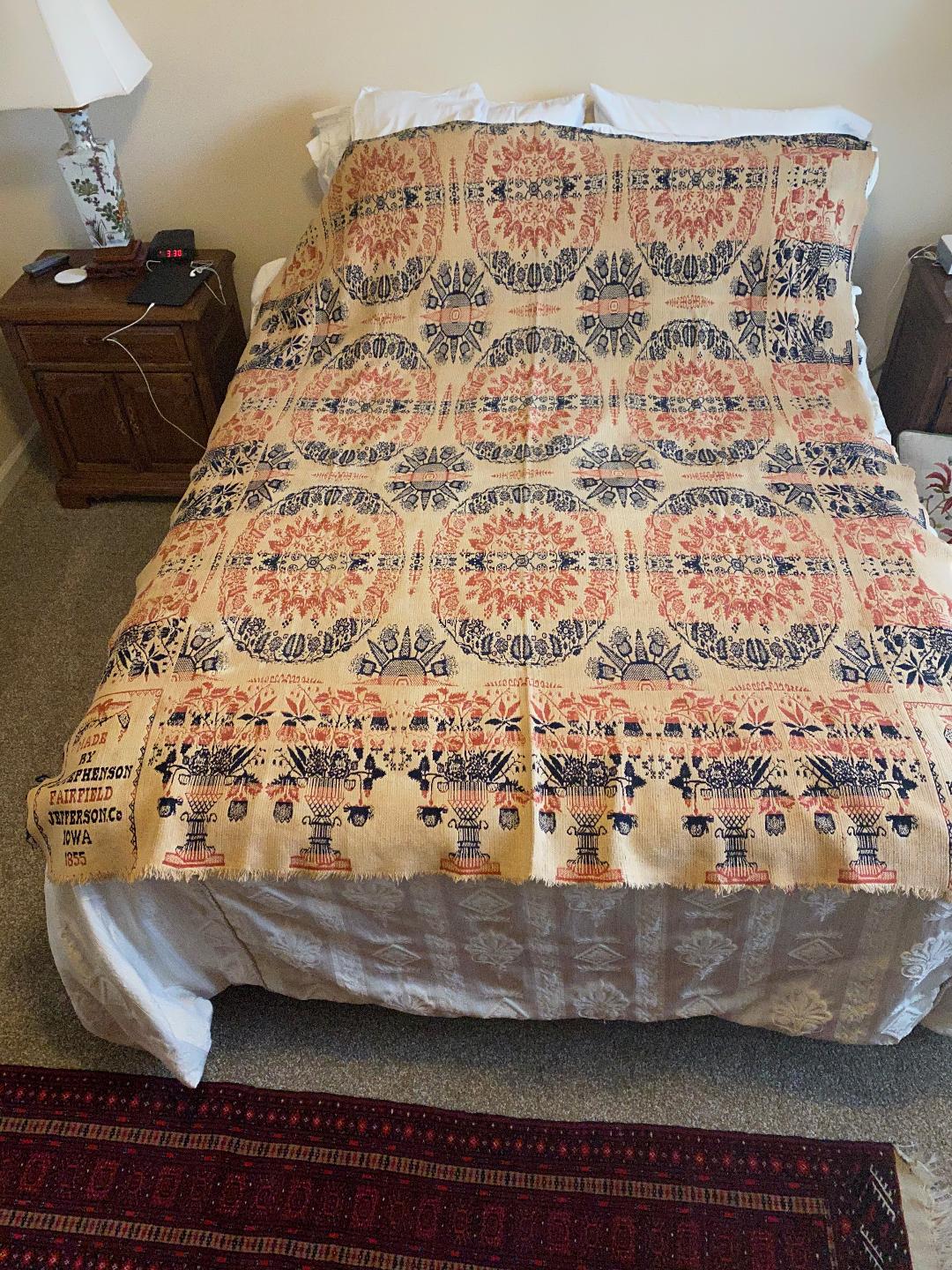 |
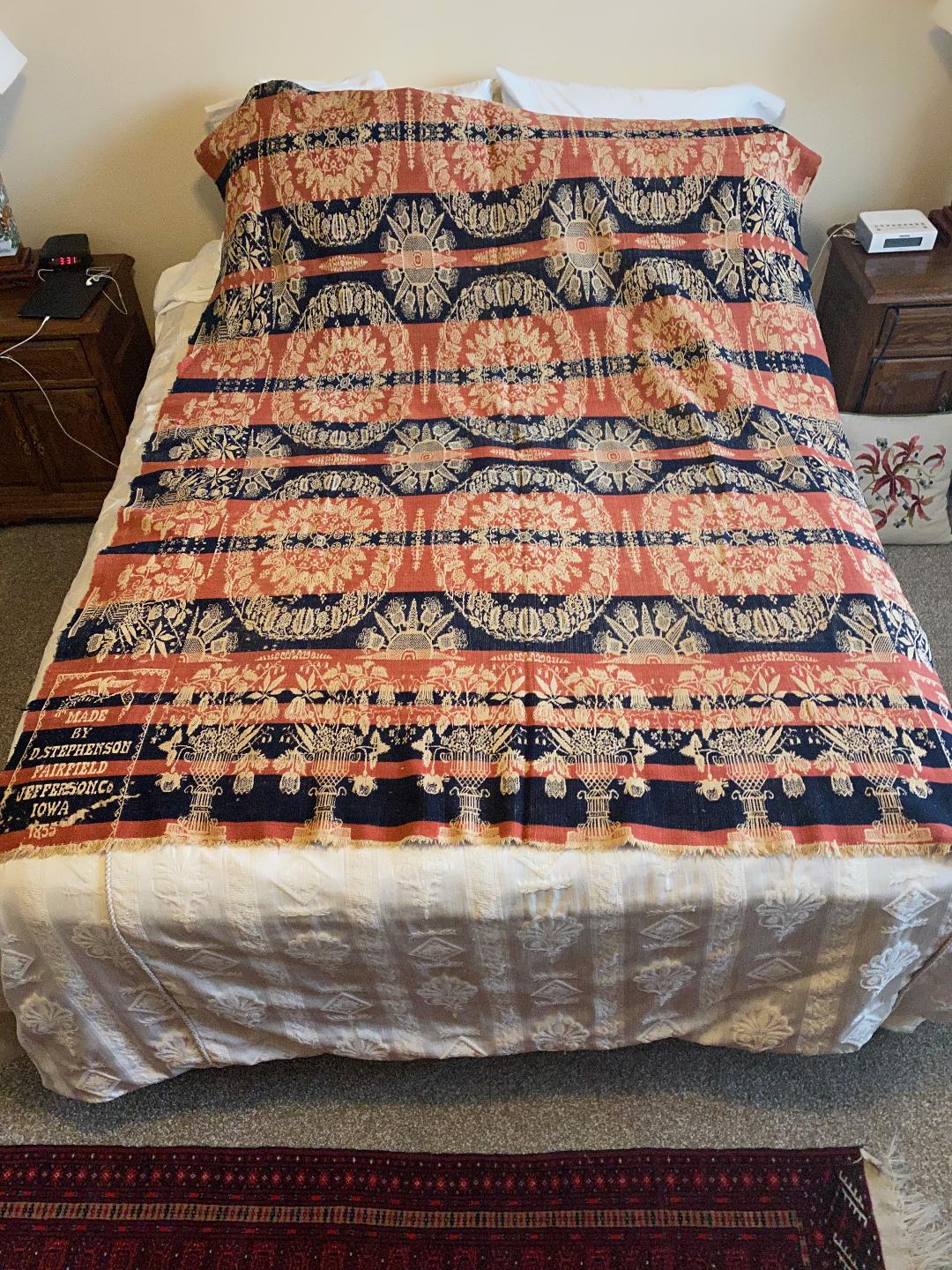 |
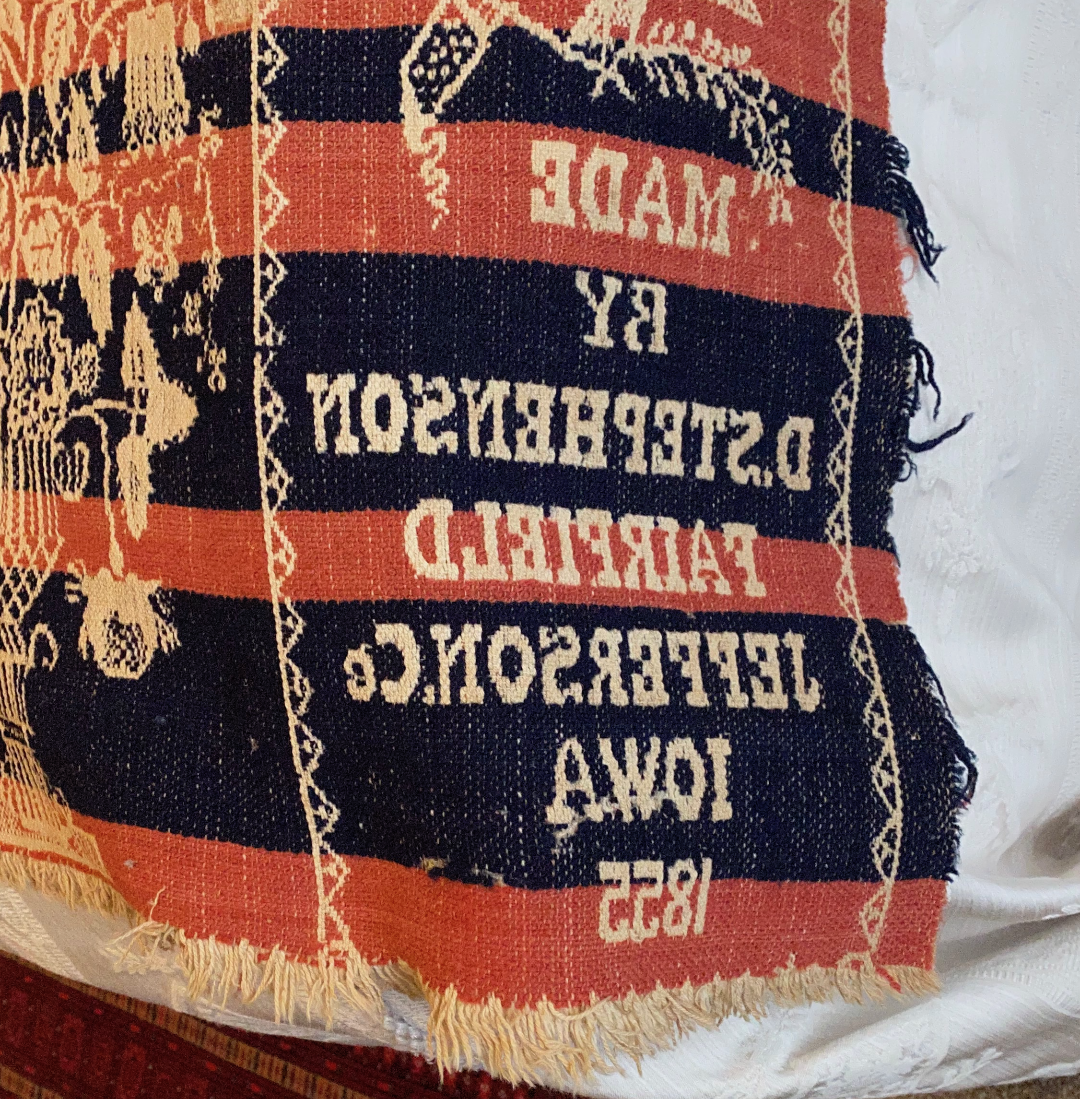 |
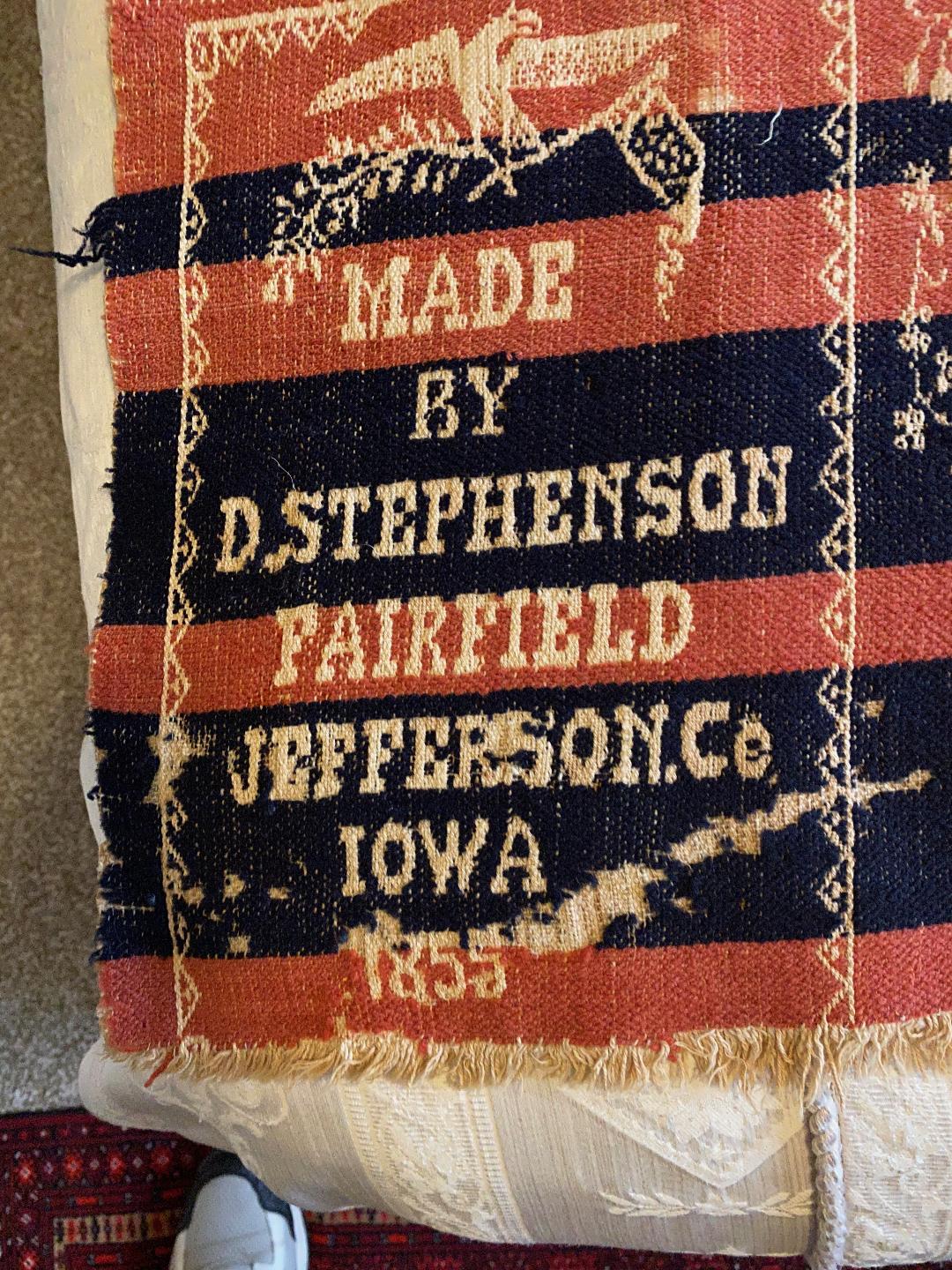 |